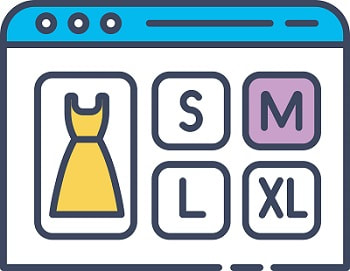The Definitive Dress Size Conversion Guide for New Zealand Shoppers
We explain everything you need to know about buying dresses in the right size. Our dress size conversion chart, must-know facts, tips and FAQs has you covered
Updated 19 October 2023
Dress sizes vary around the world, knowing your size in New Zealand provides a good starting point. From there, you can convert your dress size to the country's sizing, but always read each brand's individual sizing tips as they vary widely.
Our guide covers:
Dress sizes vary around the world, knowing your size in New Zealand provides a good starting point. From there, you can convert your dress size to the country's sizing, but always read each brand's individual sizing tips as they vary widely.
Our guide covers:
Dress Size Conversion Rules
Using the ‘conversion rules, ’ you can guess your size in international sizing, but all sizes vary by brand as well, which can make this process confusing. In general:
Top tip: Know your measurements. A size 2 in the US for one brand may be the equivalent of a size 6 in another brand – they often vary significantly. When you know your measurements, you’ll be able to choose the size in your country’s sizing and convert it to others, too.
- Subtract four sizes from your New Zealand size to get your US size
- New Zealand, Australia, and UK sizes are the same
- France, Italy, Germany, and Spain all use waist measurements rather than sizes starting at 0
- Switzerland, Scandinavia, Austria, and Holland all use German sizing
- Spain, Portugal, and Belgium all use French sizing
- For measurement sizes, 2.54 centimetres equals 1 inch
Top tip: Know your measurements. A size 2 in the US for one brand may be the equivalent of a size 6 in another brand – they often vary significantly. When you know your measurements, you’ll be able to choose the size in your country’s sizing and convert it to others, too.
Must-Know Dress Measuring Tips
Before you measure yourself, check out the following tips. You’ll measure your bust, waist, and hips, but each have different techniques/tips:
Important: Always keep the measuring tape loose – pull it too tight and you might size down, ending up with a dress that’s too tight. You should be able to fit two fingers in between the measuring tape and your skin.
- Bust - Measure your bust from the fullest part to get accurate measurements. Wrap it around, marking the measurement where the tape ends meet.
- Waist – Pull your shirt up to just below your bust. Put the measuring tape on your bare skin, not over any clothing. Start two inches above your belly button and measure all the way around, holding the measuring tape loosely.
- Hips – Stand in front of a mirror in your underwear. Start at the widest point of your hips and find the middle point. Put your thumb there and wrap the measuring tape around your hips to get the measurement.
Important: Always keep the measuring tape loose – pull it too tight and you might size down, ending up with a dress that’s too tight. You should be able to fit two fingers in between the measuring tape and your skin.
Warning Points for Online Shoe and Clothing Purchases:
- Inconsistent Manufacturer Sizing: Be aware of variations in sizing across different manufacturers and suppliers, especially for women's wear. One brand's "medium" might be another's "small". This continues to catch out New Zealanders and cause hassle.
- Prioritize Personal Measurements: Generic size charts can serve as a reference, but it's always best to rely on your measurements when making a purchase.
- Open Communication: Before committing to a purchase, establish a clear line of correspondence with the supplier. This helps in addressing potential sizing issues before they arise.
- Red Flags with Suppliers include Lack of Direct Contact (suppliers that only offer online forms and don't provide direct email addresses) and Unresponsive Customer Service (companies that don't respond or give unsatisfactory email replies can be red flags).
- Thorough Research: Dig deeper than just customer reviews. There are dedicated websites that provide insights about specific suppliers.
- Follow Company Guides: Adhere strictly to the sizing and ordering guidelines provided by the company. However, if you sense a discrepancy or have a concern, contact the company before purchasing.
- Responsibility on Companies: Once you've communicated your concerns and followed their guidelines, the company must provide accurate ordering information. If the product doesn't fit as expected, they should take responsibility.
- Leverage Chargebacks: If your purchase is unsatisfactory, consider pursuing a chargeback. Companies generally want to avoid this; sometimes, merely hinting at this action can lead to a resolution.
Dress Size Conversion Chart
S-M-L |
New Zealand, Australia & UK |
USA |
Italy |
France |
Germany |
Japan |
S |
6 |
2 |
38 |
34 |
32 |
7 |
S |
8 |
4 |
40 |
36 |
34 |
9 |
M |
10 |
6 |
42 |
38 |
36 |
11 |
M |
12 |
8 |
44 |
40 |
38 |
13 |
L |
14 |
10 |
46 |
42 |
40 |
15 |
L |
16 |
12 |
48 |
44 |
42 |
17 |
XL / 1X |
18 |
14 |
50 |
46 |
44 |
19 |
1X / 2X |
20 |
16 |
52 |
48 |
46 |
21 |
2X |
22 |
18 |
54 |
50 |
48 |
23 |
3X |
24 |
20 |
56 |
52 |
50 |
25 |
3X |
26 |
22 |
58 |
54 |
52 |
27 |
4X |
28 |
24 |
60 |
56 |
54 |
29 |
Dress Size Conversions - Frequently Asked Questions for New Zealand Shoppers
What is the average woman’s dress size in New Zealand?
The average woman in New Zealand wears a size 16 dress, despite advertisements showcasing size 12 as ‘average.’
What are sizes S – XL in the US?
It may seem confusing; the US not only has sizes with numbers but with letters too. Here are the corresponding sizes from US to New Zealand sizing. Remember, each brand varies:
- Small – Size 4 – 6
- Medium – Size 8 – 10
- Large – Size 12 – 14
- Xtra Large – Size – 16 – 18
What are the measurements for a size 12 dress in the US and size 16 in New Zealand?
A size 12/16 dress usually has the following measurements, but check each brand’s sizing and use bust size for dress sizing:
- Bust 32 – 34
- Waist 22 – 24
- Hips 33 – 35
Does height matter for dress sizing?
Height typically doesn’t factor into your dress size, but it may for preferences. For example, if you’re 6 feet tall, a size medium may be too short on you, but fit everywhere else.
What are the different dress lengths?
Dresses come in a variety of lengths, each with different names:
- Mini – The traditional mini skirt that hits mid-thigh
- Above the knee – This length is slightly longer than a mini but hits ‘above the knee’
- Knee – The dress hits at about the mid-knee
- Below knee – Most below-the-knee dresses hit an inch or two below the knee
- Below mid-calf – The dress hits just below the mid-point of your calf
- Ballerina or maxi – The dress drapes the top of your ankles
- Ankle length – The dress goes down to the end of your ankles
- Floor length – The dress drapes down to your toes
What dress length is best for tall women?
Midi or maxi length dresses are best for tall women. Midi length refers to any length from below-the-knee to floor length.
Must Know Dress Size Tips (to avoid the chance of returns and hassle)
- Know your chest, waist, and hip measurements for the best fit, as brand sizes differ
- Use your bust size as a starting point for European measurements, but you may need to size up or down
- Measure your bust without a bra for the most accurate measurements
- Size up if you are in-between sizes
- Always read sizing charts online, as many brands have unique sizing
- If you have a ‘straight body’, choose A-line dresses to add curves
- If you have a ‘pear-shaped’ figure, choose open-neck or off-the-shoulder dresses to bring attention to your upper body
- If you have an apple shape, choose empire waist dresses as the higher waistline draws the attention up
Related guides:




